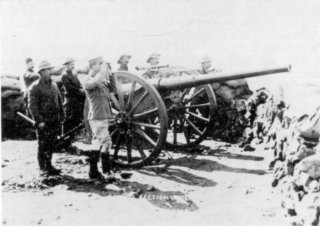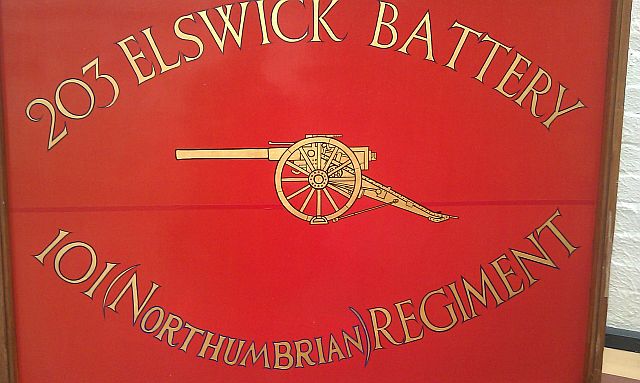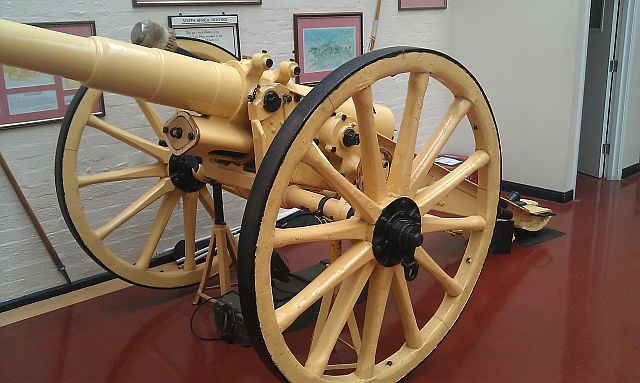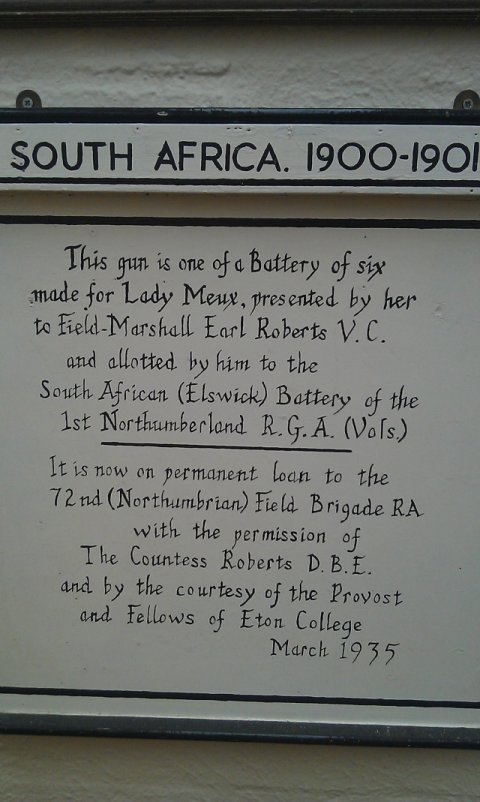

 The South African
The South African
by Major L.A. Crook
In January 1900 Sir W. G. Armstrong Whitworth Ltd. received an order from Lady Meux for six 12-pounder 3-inch Q.F. naval guns to be mounted on field carriages. The guns for this order were actually taken off a Japanese battleship which was in the Company's Naval Yard at the time (whether they were removed with the consent of the Japanese is not recorded) and their conversion to Field pieces was carried out at the Elswick Ordnance Works at Newcastle-upon-Tyne. The guns had a range of up to 10,000 yards. This was double that of the 15-pdr., then the standard armament of the British Field Artillery and nearly three times that of the R.H.A. 12-pdr. but they were rather heavier, needing four pairs of horses to pull them, as opposed to the other's three.
In February 1900 Lady Meux presented the guns to Lord Roberts, Commander-in-Chief of the British Forces in South Africa, and they became his personal property, as distinct from belonging to the army.
Meanwhile the War Office had declared a policy of accepting only infantry and yeomanry volunteers for service in South Africa - Artillery was specifically excluded. However one Unit, the 1st Northumberland Royal Garrison Artillery (Volunteers) managed to persuade officialdom to make an exception and in January 1900 authority was given for it to raise a battery for the war. This Unit had a Drill Hall near the Elswick Works, and the battery based there was composed entirely of men from the factory. The battery, which was raised for active service, came almost entirely from this drill hall and was given the title of the Elswick Battery.
It so happened that one of the Directors of Armstrong Whitworths was Sir Philip Watts, who was also Colonel of the 1st Northumberland R.G.A. (Vols.). As soon as Sir Philip heard that Lord Roberts had accepted the guns, he wired both Lord Roberts and Lady Meux to request that his service battery should be allowed to man them (they were originally to have been armed with 15-pdrs.). They both agreed. So in April 1900, 244 Officers and men comprising the Elswick Battery sailed for South Africa, probably the only gunners to be armed with field pieces which they themselves had made.
The guns were sent in crates direct from the factory to Cape Town, where they were collected by the Elswick Battery. The Battery at once set about putting the guns together, much to the subsequent wrath of the Army Ordnance Corps. However it was sensibly pointed out that if the men who made the guns could not assemble them, then who could? After about three weeks training at Maitland Camp, outside Cape Town, they went to the front. Up to September and the advance to Komatipoort, they operated as a complete battery, mainly with Sir Ian Hamilton's Division. They were then split up into sections of two guns each. One section was posted to Edenburg on the main railway line to Pretoria. This was a favourite area for Boer incursions into Cape Province. Another was attached to General Broadwood's 2nd Cavalry Brigade and was almost continuously in action in the Western Transvaal up to the end of the year, when it was split into sub-sections. One of these sub-sections remained with the 2nd Cavalry Brigade, and the other was attached to a column under Colonel Allenby. In the first quarter of 1901 both of these took part in one of the largest sweeps of the war designed to clear the Boer Commandos from the Eastern Transvaal. They remained in the Eastern Transvaal pursuing various Boer Commandos until they eventually came home. The remaining section also took part in various operations in the Western Transvaal including the relief of General Barton at Frederikstad at the end of October. In the new year they, too, were split into sub-sections and in March joined the operations in the Eastern Transvaal in columns under Colonels Gordon and Ingouville-Williams. When the Battery was split up into sections Major H. Scott, the Battery Commander, took all the spare men to Potchefstroom, where he set up his headquarters, and joined in a number of local drives and actions. Although they were fortunate in not suffering any fatal casualties from enemy action, the men of this Battery saw a considerable amount of fighting and distinguished themselves, as evidenced by the decorations they received, two DSOs, two DCMs and thirteen mentions in despatches.

In June 1901, the Battery reunited at Elandsfontein and demobilised, handing its guns over to an Artillery Militia unit which had come out from Britain. They left South Africa at the end of June and arrived back in England on l6th July, 1901.
At the end of the war Lord Roberts presented the guns to various people and places. He presented one to Ladysmith and in 1947 it was reported as still being there, near the main road in a space in front of some of the principal buildings. Another was given to Cape Town. A third he kept and up to the 1939/45 war it was mounted at his former home at "The White House", Ascot. Alas during the war it was taken away and melted down for scrap.
He presented two guns to Lady Meux, no doubt in recognition of her original gift and also for her part in equipping and running Lambton House and Hospital during the war. They were mounted at her home at Theobalds Park, Waltham Cross. In 1911 Lady Meux died, leaving the bulk of her fortune and Theobalds Park, to Captain Sir Hedworth Lambton, R.N. (of Ladysmith fame). In 1937 the guns were spotted by an Admiral who, on learning that they had been used in the Boer War, were associated with Sir Hedworth and were naval pattern guns, assumed that they were probably two of the guns provided and manned by the Navy during the siege of Ladysmith. The owner of Theobalds Park (who had bought it complete with two field guns) agreed to give the guns to the Navy. These guns are now at the naval shore establishment at H.M.S. Excellent, Whale Island, Portsmouth, where they are mounted on top of the bank overlooking the parade ground, outside the old Guard Room, which is now the Armoury and Gunners Store.
The remaining gun was given to Eton College, where for years it was climbed over by generations of small boys. In 1935 it was spotted quite by chance by the Second-in- Command of the Regiment (now called the 72nd (N) Field Brigade R.A. (T.A.), who was visiting Eton with an old Etonian and former member of the Regiment. The provost kindly agreed to give it to the Regiment. As the gun was practically derelict, it was sent to be refurbished at the Elswick Works, which, incredibly, still had the necessary spares in store. During the 1939/45 war the gun was hidden (to avoid its being melted down for scrap) at the country home in Northumberland of Colonel H. S. Bell, who had actually served as a subaltern with the Elswick Battery in South Africa. Somehow Col. Bell contrived to lay hands on five rounds of ammunition with the intention of using them on the Germans should they ever reach Northumberland, a need which fortunately did not arise. This gun is still at the old Regimental Headquarters at Barrack Road, Newcastle-upon-Tyne, although, as a result of the disbandment of the Territorial Army on 31st March 1967 the Drill Hall now belongs to the successor Unit 101 (N) Medium Regiment R.A. (V).
(EDITOR'S NOTE.- Major J. S. Douglass, TD, of 32, Reid Park Road, Newcastle-upon-Tyne,
2, England, is presently writing a history of the 1st Northumberland Royal
Garrison Artillery (Volunteers) and is anxious to trace the two guns left
in South Africa.
Anyone who is able to assist Major Douglass in this regard is asked to
kindly communicate with him direct.)
In June 2012 the following was received by e-mail from Eyton Parker, currently Battery Commander:
With reference to the [above] article, I am in a position to shed more light on where two of the Elswick Guns now reside. The Eton college gun now resides in the drill hall at Blyth in Northumbria in 203 (Elswick) Battery. Our Battery plaque is red with a picture of the gun on it.

The gun is in reasonable condition but has few ancilleries.


The plaque in the museum
There is another gun at the Defence College at Shrivenham in a facility there that shows the development of weapon systems. The gun is in excellent condition inc its sights. I do not know which gun of the six this is.
I am sad to report that the Vickers BAE factory still in Elswick has this month announced that it is to close.
Eyton Parker
Battery Commander
203(Elswick) Battery
Ubique Quo Fas et Gloria Ducunt
Return to Journal Index OR Society's Home page
South African Military History Society / scribe@samilitaryhistory.org